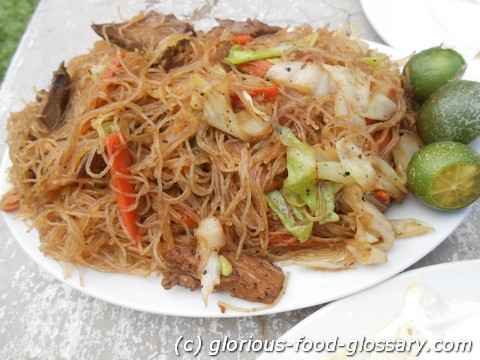Deutsch: Pancit Bihon / Español: Pancit Bihon / Português: Pancit Bihon / Français: Pancit Bihon / Italiano: Pancit Bihon
Pancit Bihon in the food context refers to a popular Filipino noodle dish made from bihon (thin rice noodles) and a variety of other ingredients such as sliced meat (usually chicken, pork, or shrimp), vegetables (commonly cabbage, carrots, and green beans), and sometimes seafood. The dish is seasoned with soy sauce, and occasionally fish sauce or oyster sauce, for added flavor. Pancit Bihon is known for its versatility and is a staple at Filipino gatherings and celebrations, symbolizing long life and good health according to Filipino tradition.
Description
Pancit Bihon is appreciated for its light yet savory flavor profile and the mix of textures from the soft noodles and crisp vegetables. This dish is often garnished with sliced green onions, fried garlic bits, and lemon or calamansi (a small Philippine lime) wedges to squeeze over the top before eating, enhancing its taste with a touch of acidity.
Application Areas
Pancit Bihon is commonly served as:
- Main Dish: Often enjoyed for lunch or dinner and is a common offering at Filipino restaurants worldwide.
- Celebratory Food: A must-have during birthdays, fiestas, and other special occasions, symbolizing wishes for a long and prosperous life.
- Everyday Meal: Due to its ease of preparation and nutritious ingredients, it's also a popular choice for everyday meals.
Well-Known Examples
While Pancit Bihon itself is a specific dish, it is part of the larger family of pancit (noodle) dishes in the Philippines, which includes:
- Pancit Canton: A dish similar to Pancit Bihon but made with wheat noodles instead of rice noodles.
- Pancit Palabok: Rice noodles covered with a golden shrimp sauce and topped with shrimp, boiled eggs, green onions, and fried garlic.
Recipes
A basic recipe for making Pancit Bihon involves:
-
Ingredients:
- 8 oz bihon (rice noodles)
- 2 tablespoons cooking oil
- 2 cloves garlic, minced
- 1 onion, sliced
- 1/2 pound thinly sliced meat (chicken, pork, or shrimp)
- 2 cups mixed vegetables (such as cabbage, carrots, and green beans), sliced
- 1/4 cup soy sauce, or to taste
- 2 cups chicken broth or water
- Salt and pepper to taste
- Lemon or calamansi wedges for serving
-
Preparation:
- Soak the bihon noodles in water for about 10 minutes, then drain.
- Heat oil in a large skillet or wok. Sauté garlic and onion until translucent.
- Add the meat and cook until lightly browned. Add the vegetables and stir-fry until tender-crisp.
- Add the drained noodles, soy sauce, and chicken broth or water. Toss everything together and cook until the noodles are soft and the liquid is absorbed.
- Season with salt and pepper to taste.
- Serve hot, garnished with lemon or calamansi wedges.
Treatment and Risks
Pancit Bihon is generally considered a healthy dish, especially when loaded with vegetables. However, those watching their sodium intake should moderate the amount of soy sauce and salt used in the recipe. The dish is gluten-free if gluten-free soy sauce is used, making it suitable for those with gluten sensitivities.
Similar Terms or Synonyms
- Filipino Rice Noodles
- Bihon Guisado
Summary
Pancit Bihon is a beloved Filipino noodle dish known for its delightful mix of flavors and textures, bringing together thin rice noodles, meat, vegetables, and a savory seasoning. It plays a significant role in Filipino culinary tradition, celebrated for its symbolic meaning and enjoyed across various occasions and everyday meals.
--

Related Articles to the term 'Pancit Bihon' | |
| 'Pancit Canton' | ■■■■■■■■■■ |
| Pancit Canton is a traditional Filipino noodle dish that is both versatile and beloved across the Philippines. . . . Read More | |
| 'Pancit' | ■■■■■■■ |
| Pancit is the Filipino generic term for \'noodles\'. There are various kinds of noodle dishes in the . . . Read More | |
| 'Lumpiang Gulay' | ■■■■■■■ |
| Lumpiang Gulay in the food context refers to a Filipino dish consisting of vegetable spring rolls. These . . . Read More | |
| 'Giniling na Munggo' | ■■■■■■ |
| Giniling na Munggo in the food context refers to a Filipino dish made from ground or mashed mung beans . . . Read More | |
| 'Lomi' | ■■■■■ |
| Lomi also called Pancit, Lomi is one of the varieties of noodle dishes in the Philippines. Lomi is a . . . Read More | |
| 'Pancit Miki' | ■■■■■ |
| Pancit Miki is another variant of the broad family of noodle dishes in Filipino cuisine, distinguished . . . Read More | |
| 'Jeot (Jeotgal)' | ■■■■■ |
| Jeot (Jeotgal) : Jeot more popularly known as Jeotgal refers tp salted fermented food in Korean cuisine. . . . Read More | |
| 'Ginisang Labong' | ■■■■■ |
| Ginisang Labong in the food context refers to a Filipino dish made from sautéed bamboo shoots, known . . . Read More | |
| 'Lumpiang Shanghai' | ■■■■■ |
| Lumpiang Shanghai in the food context refers to a popular Filipino dish consisting of thin, spring roll . . . Read More | |
| 'Lumpiang Toge' | ■■■■■ |
| Lumpiang Toge in the food context refers to a Filipino dish consisting of spring rolls filled with mung . . . Read More | |
